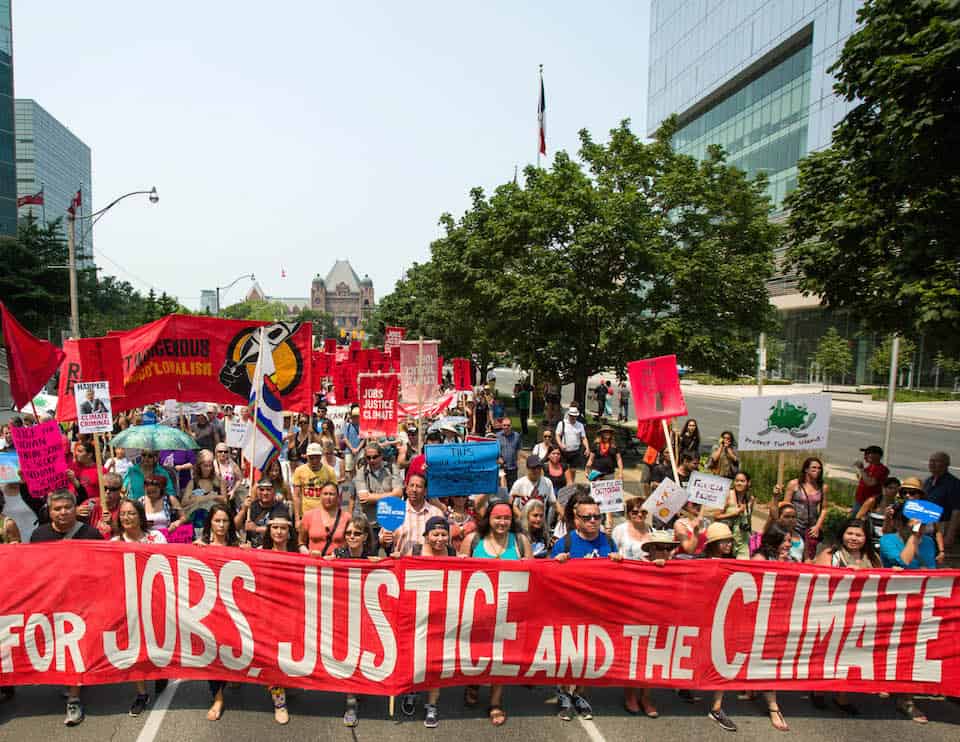On July 5, 2015, a crowd of 10, 000 gathered in front of the Ontario Legislature Building, which was the starting point of their march for a more ample, yet sustainable economy and environment. The March for Jobs, Justice, and Climate Change was, according to Amanda Harvey-Sanchez, media coordinator for Toronto350 and a member of FossilFree U of T, a step forward in the fight against social injustice, inequality, and the exploitation of the planet.
The march was comprised of four contingents, each representing a certain aspect of the movement.
Harvey-Sanchez said of the first group that, “‘It Starts with Justice’ demonstrated that the climate movement is lead by the struggles of Indigenous and frontline communities, migrant and gender justice groups, racialized groups, and anti-poverty activists.” She went on to say that “‘Good Work, Clean Jobs, Healthy Communities’ comprised labour unions, non-unionized workers, anti-poverty organizations and aimed to show that climate action can strengthen our economy, [whereas] ‘We Have Solutions’ was about showing that many of the solutions to the climate crisis already exist and that if politicians refuse to lead the way, these groups (students and youth) will lead instead.” The final group, ‘We Know Who is Responsible’ was intended to raise awareness about those responsible for the climate crisis and to recognize the necessity of transitioning to a green economy.
The act of linking jobs and justice issues with climate action was, for some attendees, one of the most attractive, and unique, aspects of the march. “Connecting the economy and the environment creates a stronger voice. I mean, how can people be focused on protecting the environment if they can’t even pay rent,” commented Deena Ladd, an attendee of the march, and a member of the Workers Action Centre.
For many, the march was a means of applying political pressure seeking to increase awareness of climate change and to entrench the question as an election issue in Canada.
“We are currently in the middle of an existentialist crisis and the government isn’t doing anything,” said Gord Miller, who recently stepped down from his position as Ontario Environmental Commissioner and is currently running for office in Guelph. “This is society’s way of saying that we are ready to do what the government isn’t and we are taking a stand for an increasingly critical issue,” he commented while walking down University Avenue as part of the march’s route.
A couple of days prior to the march, members of Fossil Free U of T and Toronto350 staged a sit-in at political offices in order to pressure politicians to engage with the issue of climate change. “The sit-in was one of six direct actions that ensued on the Friday before the March, and one of many actions during the course of the weekend. Two groups actually were able to meet with Tom Mulcair and have a conversation about his forthcoming economic and environmental plan. This is a win,” said Leila Atri, Victoria College’s sustainability commissioner, who was also present at the march itself.
Overall, the march was deemed a huge success and attracted a great deal of media attention. “So many people have told me that the march inspired them to be involved in some way in the climate movement. To me, that is one of the greatest successes of the march. The fight for climate justice can often be a depressing one as there are so many obstacles and setbacks, but when people from diverse groups are able to come together in support of a common goal, we create hope for a better future and we are powerful,” said Harvey-Sanchez.


